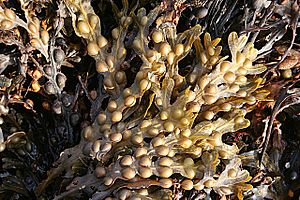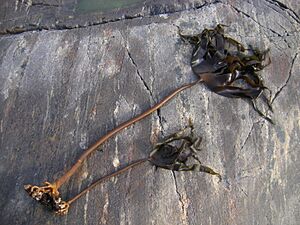Brown algae facts for kids
Quick facts for kids Brown algae |
|
|---|---|
 |
|
| Giant kelp (Macrocystis pyrifera) | |
| Scientific classification | |
| Domain: | |
| Kingdom: | |
| Division: | |
| Class: |
Phaeophyceae
Kjellman, 1891
|
| Orders | |
|
see Classification. |
|
| Synonyms | |
|
Fucophyceae |
|
Brown algae are a big group of algae. They are a special type of living thing called 'protists'. They are not plants or animals. All brown algae are made of many cells, not just one. Most get their brown color from a special chemical called fucoxanthin.
There are about 2,000 different kinds of brown algae. Most live in the ocean. They are super important! Many ocean animals use them for food and shelter. People even eat some types of brown algae. Giant kelp, like Macrocystis, can grow into huge underwater 'forests'. It can reach up to 60 meters (nearly 200 feet) long! The Sargasso Sea gets its name from the Sargassum seaweed that floats on its surface. Many brown algae also grow on rocks along the seashore.
Contents
What Do Brown Algae Look Like?
Brown algae come in many different shapes and sizes. The smallest ones are tiny, feathery threads. They are only a few centimeters long. Some are so small you need a microscope to see them!
Other types of brown algae grow much larger. Rockweeds and leathery kelps are often easy to spot where they live. Kelps can be small, like the two-foot-tall sea palm Postelsia. Or they can be giant, like Macrocystis pyrifera, which can grow over 45 meters (150 feet) long! This makes it the biggest alga of all.
Brown algae can look like small crusts or cushions. Some form flat, floating mats, like Sargassum. Others are delicate, felt-like strands, such as Ectocarpus. Some even look like foot-long flattened fans, like Padina.
Special Features of Brown Algae
No matter their size or shape, brown algae have two main features that make them unique.
First, they have a special color. It can be anything from olive green to different shades of brown. The exact shade depends on how much fucoxanthin chemical they have.
Second, all brown algae are made of many cells (multicellular). You won't find any brown algae that are just single cells or groups of cells living together. This makes them the only major group of seaweeds that are always multicellular.
Parts of a Brown Alga
The body of a brown alga is called a thallus. This means it doesn't have the complex tubes (xylem and phloem) that real vascular plants have for carrying water and food. But brown algae still have special parts!
- Holdfast: This is a root-like part at the bottom of the alga. It acts like an anchor, holding the alga firmly to rocks or other surfaces. This stops the alga from floating away in the currents. Unlike plant roots, the holdfast usually doesn't take in water or food from the ground. It can look branched or like a cup. Most algae have one holdfast.
- Stipe: This is a stalk or stem-like part. It can be short, like in Laminaria. Or it can be long and complex, running through the whole alga, like in Sargassum or Macrocystis. In some complex brown algae, the stipe has three layers, similar to a plant stem. Some stipes have special cells that carry food, like the phloem in plants. Others, like in Nereocystis, have a hollow center filled with gas. This gas helps the alga float. The stipe can be flexible, like in Macrocystis pyrifera, or stiff, like in Postelsia palmaeformis.
- Blade or Frond: This is the flat, leaf-like part of the alga. A single, undivided flat part is often called a blade. If the whole flat body is divided, it might be called a frond. In rockweeds, the blade is a wide tissue that runs along both sides of a central 'midrib'.
Some brown algae have one blade, while others have many. Strong currents can sometimes tear a single blade into many pieces. Blades can be smooth or wrinkled. They can be thin and bendy or thick and leathery. The surface of the blade is often covered in slime. This slime helps stop other small plants from growing on it. It also helps keep animals from eating it. The blades are also often where the alga's reproductive parts are found.

- Pneumatocysts (Air Bladders): These are gas-filled floats that help many kelps and other brown algae float. They are usually found on or near the blades. This helps the blades stay closer to the water's surface, where they can get more sunlight for making food. Pneumatocysts are usually round or oval.
Some species, like Nereocystis luetkeana, have one big air bladder at the top of their stipe. Giant kelp (Macrocystis pyrifera) has many blades along its stipe, and each blade has a small air bladder at its base. Sargassum also has many blades and air bladders, but they are attached separately to the stipe by short stalks. In Fucus, the air bladders grow inside the blade itself.
Why Are Brown Algae Important?
Brown algae are very useful!
- Food and Products: Many brown algae are edible seaweeds. All brown algae have a substance called alginic acid (or alginate) in their cell walls. This is taken out and used in many ways. It's a thickening agent in foods like ice cream and salad dressing. It's also used in other products, like Lithium Ion batteries. Alginic acid helps make the battery parts more stable. This special substance is only found in brown algae, not in land plants.
- Helping Fish: Alginic acid can also be used in aquaculture (fish farming). For example, it can make the immune system of rainbow trout stronger. Younger fish are more likely to survive if they eat food with alginic acid.
- Fighting Climate Change: Brown algae, especially in huge kelp beds, help the Earth by taking in a lot of carbon dioxide each year through photosynthesis. This helps clean the air.
- Medicine: Some extracts from brown algae, like Sargachromanol G from Sargassum siliquastrum, have been shown to help with swelling and pain (anti-inflammatory effects).
Images for kids
See also
 In Spanish: Algas pardas para niños
In Spanish: Algas pardas para niños



